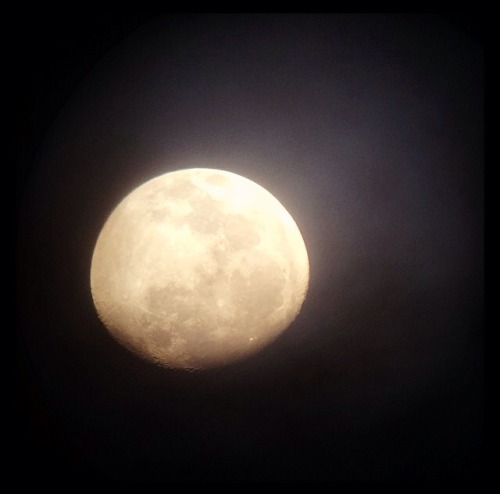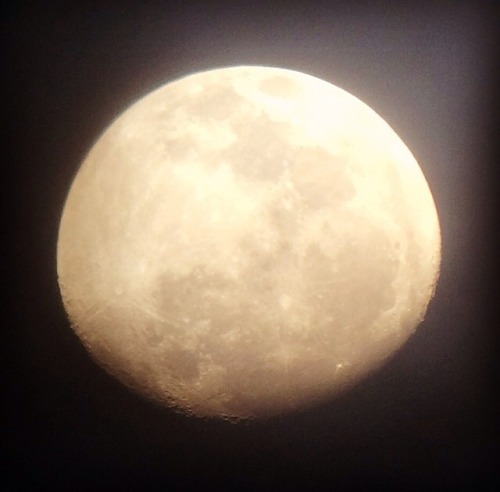Jupiter’s Moon, Callisto.
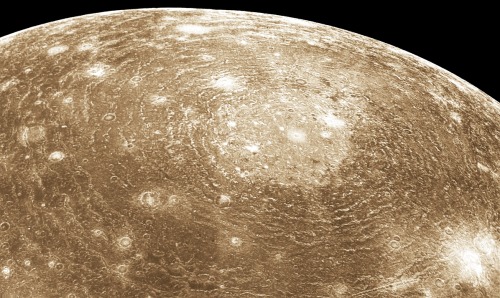
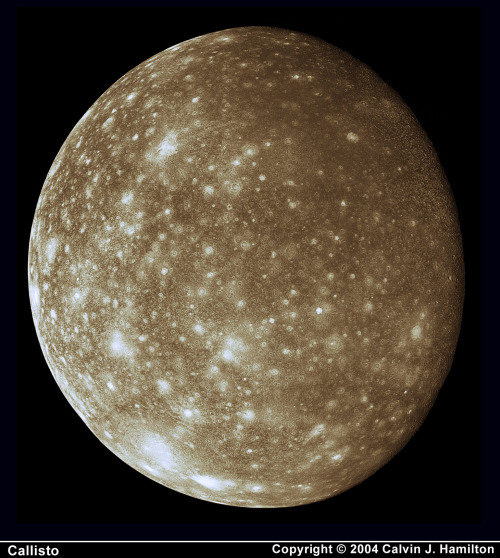
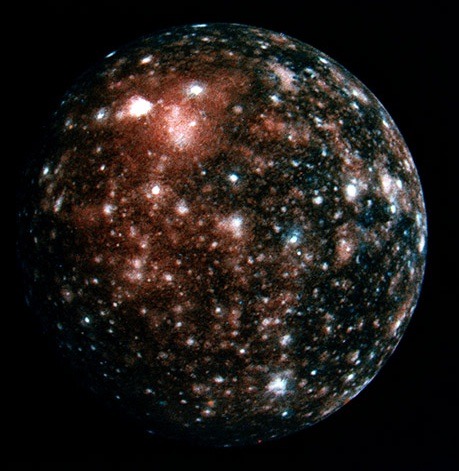

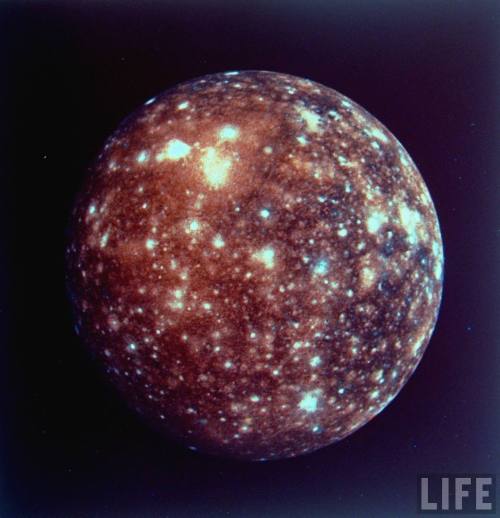
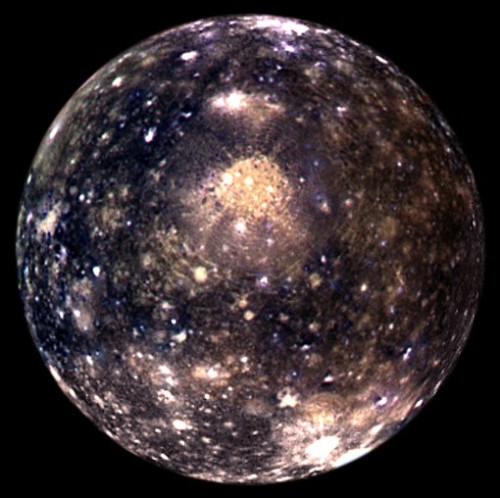

Jupiter’s moon, Callisto.
More Posts from Xnzda and Others

The Egg Nebula
The Egg Nebula is approximately 3,000 Light years away from Earth.Resembling a rippling pool illuminated by underwater lights, the Egg Nebula offers astronomers a special look at the normally invisible dust shells swaddling an aging star. These dust layers, extending over one-tenth of a light-year from the star, have an onionskin structure that forms concentric rings around the star.
Image credit: NASA

Solarbeat
This is magical. whitevinyldesign.com/solarbeat
via wired
Because every planet has its own orbital period, “it ends up generating this unending, interesting pattern,” Twyman says. For example, Mercury, which has an orbit of 88 Earth days, is the backbeat to the sound, while Pluto, which takes approximately 248 years to orbit the sun, rarely makes an appearance in the music. “It really lends itself to generating ambient music,” he says. You can tweak the speed of orbit, slowing it down to make a soothing tinkle of a child’s mobile or speeding it up to orchestrate a chaotic planetary choir. New features allow you to add sound effects like echo, flutter and bass, and you can choose from eight different chords to personalize the sound. READ MORE

M51: The Whirlpool Galaxy
Credit: NASA, ESA, S. Beckwith (STScI), and the Hubble Heritage Team (STScI/AURA)

At the Heart of Orion.

A cosmic blossom
IC 5148 is a beautiful planetary nebula located some 3000 light-years away in the constellation of Grus (The Crane). The nebula has a diameter of a couple of light-years, and it is still growing at over 50 kilometres per second — one of the fastest expanding planetary nebulae known. The term “planetary nebula” arose in the 19th century, when the first observations of such objects — through the small telescopes available at the time — looked somewhat like giant planets. Although the name stuck, it represents the expanding shell of gas ejected from old red giant stars late in their lives.
And now this one resembles a lovely blossom with layered petals.
Credit: European Southern Observatory

Image of Messier 81 (M81). Located about 12 million light-years away in the Ursa Major constellation, M81 is among the brightest of the galaxies visible by telescope from Earth.
Image credit:NASA/JPL-Caltech/ESA/Harvard-Smithsonian CfA

Tilt-shift photo of the space shuttle Endeavour by NASA
https://www.nasa.gov/mission_pages/shuttle/flyout/multimedia/endeavour/11-05-16-2.html
-
 the-real-pink-ninja liked this · 3 weeks ago
the-real-pink-ninja liked this · 3 weeks ago -
 midnight-reader-morning-sleeper liked this · 1 month ago
midnight-reader-morning-sleeper liked this · 1 month ago -
 worldweaverofmediocrity reblogged this · 1 month ago
worldweaverofmediocrity reblogged this · 1 month ago -
 catkin-morgs-kookaburralover liked this · 1 month ago
catkin-morgs-kookaburralover liked this · 1 month ago -
 the-land-of-eternal-winter-novel reblogged this · 1 month ago
the-land-of-eternal-winter-novel reblogged this · 1 month ago -
 jellycaustic reblogged this · 1 month ago
jellycaustic reblogged this · 1 month ago -
 blade-liger-4ever liked this · 1 month ago
blade-liger-4ever liked this · 1 month ago -
 vitamaeternum reblogged this · 1 month ago
vitamaeternum reblogged this · 1 month ago -
 vitamaeternum liked this · 1 month ago
vitamaeternum liked this · 1 month ago -
 lenjaminmacbuttons liked this · 1 month ago
lenjaminmacbuttons liked this · 1 month ago -
 polyglot-thought-2 liked this · 1 month ago
polyglot-thought-2 liked this · 1 month ago -
 scribbly-bear liked this · 1 month ago
scribbly-bear liked this · 1 month ago -
 pensandsliverswords reblogged this · 1 month ago
pensandsliverswords reblogged this · 1 month ago -
 pensandsliverswords liked this · 1 month ago
pensandsliverswords liked this · 1 month ago -
 herebesherlocks reblogged this · 1 month ago
herebesherlocks reblogged this · 1 month ago -
 professor-cold-ramen liked this · 1 month ago
professor-cold-ramen liked this · 1 month ago -
 learlir liked this · 1 month ago
learlir liked this · 1 month ago -
 thejonderettegirl liked this · 1 month ago
thejonderettegirl liked this · 1 month ago -
 tzarina-alexandra reblogged this · 1 month ago
tzarina-alexandra reblogged this · 1 month ago -
 angelbornaltruist liked this · 1 month ago
angelbornaltruist liked this · 1 month ago -
 liamins liked this · 1 month ago
liamins liked this · 1 month ago -
 greengrace reblogged this · 1 month ago
greengrace reblogged this · 1 month ago -
 alchemisticramblings reblogged this · 1 month ago
alchemisticramblings reblogged this · 1 month ago -
 alchemisticramblings liked this · 1 month ago
alchemisticramblings liked this · 1 month ago -
 inkyrainstorms liked this · 1 month ago
inkyrainstorms liked this · 1 month ago -
 fancytomato reblogged this · 1 month ago
fancytomato reblogged this · 1 month ago -
 fancytomato liked this · 1 month ago
fancytomato liked this · 1 month ago -
 alcadanon reblogged this · 1 month ago
alcadanon reblogged this · 1 month ago -
 alcadanon liked this · 1 month ago
alcadanon liked this · 1 month ago -
 marie-pippins liked this · 1 month ago
marie-pippins liked this · 1 month ago -
 indynerdgirl reblogged this · 1 month ago
indynerdgirl reblogged this · 1 month ago -
 starfayy liked this · 1 month ago
starfayy liked this · 1 month ago -
 livingandthriving liked this · 1 month ago
livingandthriving liked this · 1 month ago -
 aevarswall reblogged this · 1 month ago
aevarswall reblogged this · 1 month ago -
 aevarswall liked this · 1 month ago
aevarswall liked this · 1 month ago -
 screwtornadowarningsimsouthern reblogged this · 1 month ago
screwtornadowarningsimsouthern reblogged this · 1 month ago -
 argen-lobo-ridder reblogged this · 1 month ago
argen-lobo-ridder reblogged this · 1 month ago -
 banana-with-a-bow-tie reblogged this · 1 month ago
banana-with-a-bow-tie reblogged this · 1 month ago -
 ladypyewacket reblogged this · 1 month ago
ladypyewacket reblogged this · 1 month ago -
 noelia-diaz06 liked this · 1 month ago
noelia-diaz06 liked this · 1 month ago -
 strawberry-muffin-crisis liked this · 1 month ago
strawberry-muffin-crisis liked this · 1 month ago -
 tealfoxarts liked this · 1 month ago
tealfoxarts liked this · 1 month ago -
 vio1315 liked this · 1 month ago
vio1315 liked this · 1 month ago -
 jacepi-time reblogged this · 1 month ago
jacepi-time reblogged this · 1 month ago -
 toothpaste-dragon liked this · 1 month ago
toothpaste-dragon liked this · 1 month ago -
 theworldoffandoming reblogged this · 1 month ago
theworldoffandoming reblogged this · 1 month ago -
 kazeharuhime liked this · 1 month ago
kazeharuhime liked this · 1 month ago -
 banana-with-a-bow-tie liked this · 1 month ago
banana-with-a-bow-tie liked this · 1 month ago -
 thegreatclowncat reblogged this · 1 month ago
thegreatclowncat reblogged this · 1 month ago -
 firefletch liked this · 1 month ago
firefletch liked this · 1 month ago


